No going back: A conversation with Netflix Culture Deck creator Patty McCord

Before becoming a household name as the world’s leading streaming service, Netflix went viral in Silicon Valley for creating one of the most revolutionary documents in people management – the Netflix Culture Deck.
In a nutshell, the Powerpoint deck outlined how Netflix created a culture of learning to break free from its DVD subscription service and launch itself into the streaming service space.
Since its release in 2009, the Netflix Culture Deck has been viewed more than 5 million times and has challenged how many HR and L&D professionals view purpose in their business.
Now that the world has undergone massive transformation overnight, we invited the creator of the Netflix Culture Deck and former Chief of Talent Officer Patty McCord to dive into how to build a culture of learning that will help your business navigate through a period of significant change at Rewrite The Playbook – and how there’s no going back after a period of great experimentation like the one we’re seeing now.
Looking to embed what you’ve learned from the pandemic into your business? Here are McCord’s top tips for challenging the status quo in your organization:
Treat your employees like adults
At the onset of the pandemic, business leaders were scrambling to find new ways to measure employee performance when social distancing measures and stay-at-home orders made it difficult for management to see how hard they’re working, if they’re at the office, or if they’re using their voice in the meeting.
In reality, these metrics don’t matter.
Measure people by what they get done. You don’t have to keep track of everybody. Oftentimes, it’s a matter of saying, ‘Hey, can you have this done by Friday?’ and you can trust that your employees will follow through.
Scrap performance reviews
When we change the metrics of employee performance from how hard your employees appear to be working to what they actually accomplish, it also requires a change in how frequently they receive performance feedback.
Previously, performance reviews were usually when managers tell their employees how they’ve gone over the past 12 months. But, oftentimes only recent projects are mentioned, leaving many great projects without recognition. By creating more frequent check-ins, it allows managers and employees to celebrate the wins and quickly correct performance issues before they become a problem. More importantly, it takes away the fear of receiving performance feedback from management, which can actually decrease employee motivation.
Employees are motivated at work when they make progress. So, focus feedback on what will move the project, their career, and ultimately, the business forward.
Tie training to business goals
Before the pandemic, training often took place in a white-walled room or a back-office for an hour. Employees knew that it was something you had to do to pass to either be able to complete your work or receive certificate.
Now that many of us were forced to shake previous processes and procedures, it’s an opportunity to give your people the tools they need to learn and be successful. One of the best ways to do this is to build your training with the end-user in mind. This means tying your learning and training back to your organization’s goals and the customer experience. The more your employees know about how and why your company is working toward a specific goal, the better they will be able to fulfill their role in serving the customer.
Model the behavior you want to see
In a time of change, it’s more important than ever to model and encourage the behavior you want to see in your employees. As a leader, you are responsible for setting expectations for how communication, flexibility, and innovation will look like in your company – and embed these behaviors into your company culture.
With this ever-changing landscape of government restrictions, and remote and hybrid work, it’s important that your employees know that it’s safe for them to innovate and fail. This will empower your employees to make decisions in the company’s best interest, as opposed to following processes and procedures that may no longer be effective or relevant.
Determine what’s working
In the learning and development space, we have a bad habit of carrying inefficient processes over and over. No one else in any other part of your organization is allowed to do it, and somehow L&D never throws anything away – we just keep adding more and more. With many people still working from home, it’s ineffective to update all of these existing procedures, processes, and courses.
Make a list of what’s worked and what’s not to see what trends emerge. Right now, you have the opportunity to optimize how your organization operates and delivers its training. Every day ask yourself: Is that need still there? Is it the same need as when we created it? If we had to do it again, would we?
This will allow you to measure what is driving success to your employee – and therefore the business – as a result of rolling out that course.
No best practices
Most importantly – forget what other learning and development teams are doing. What’s working at Facebook won’t work if you’re a tech start-up. Make your training centered around your organization’s goals to ensure that it’s right for your teams and your business.
Ready to learn more about how to challenge the status quo?
Join Patty McCord and other industry changemakers at EdApp’s summit on April 29 and learn everything on the Netflix Culture Deck and more.
Author
Shera Bariuad
Shera is a workplace learning expert with a background in planning performance-driven solutions for various business industries. She’s dedicated to driving better learning and development outcomes by providing training strategies for training managers and curating lists of tools and courses for learners. Outside of work, she spends her time reading, illustrating, and designing.
